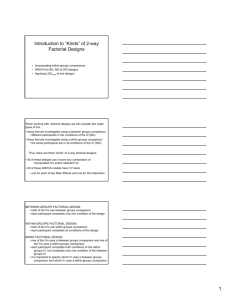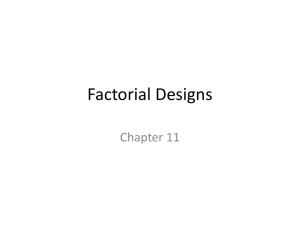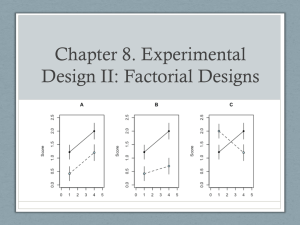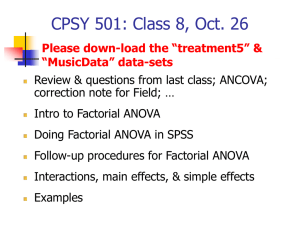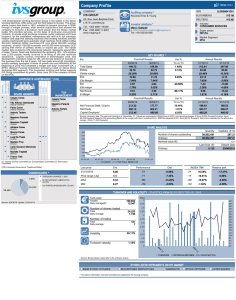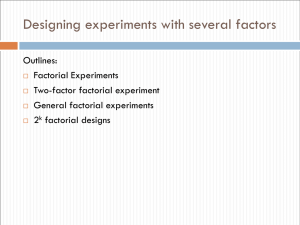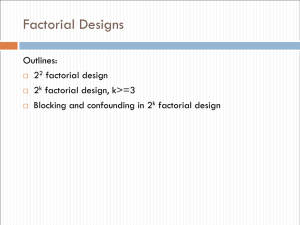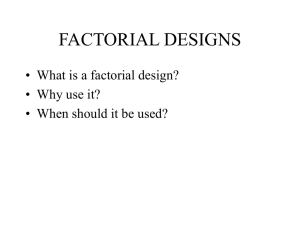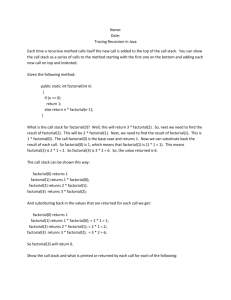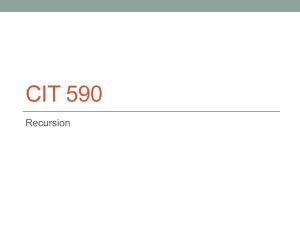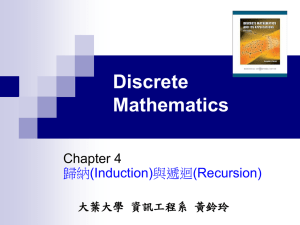Factorial Designs
advertisement
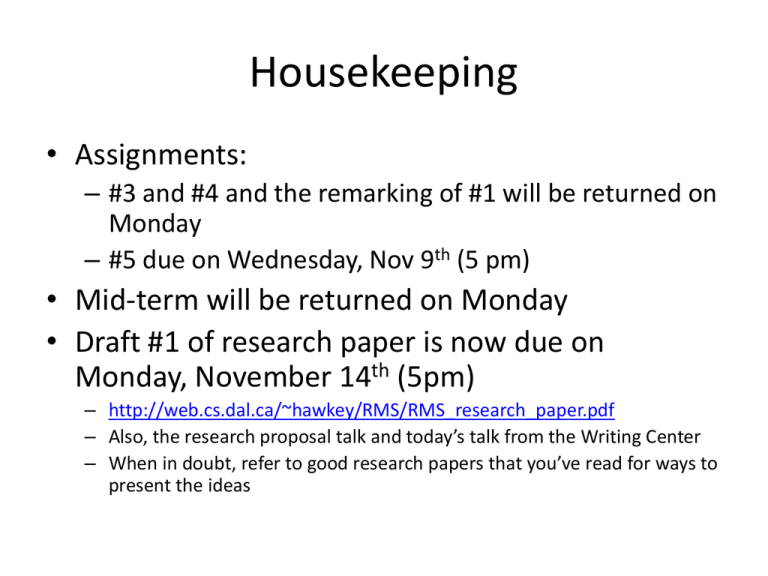
Housekeeping • Assignments: – #3 and #4 and the remarking of #1 will be returned on Monday – #5 due on Wednesday, Nov 9th (5 pm) • Mid-term will be returned on Monday • Draft #1 of research paper is now due on Monday, November 14th (5pm) – http://web.cs.dal.ca/~hawkey/RMS/RMS_research_paper.pdf – Also, the research proposal talk and today’s talk from the Writing Center – When in doubt, refer to good research papers that you’ve read for ways to present the ideas Factorial Designs Research Methods & Statistics Fall 2011 Kirstie Hawkey Example drawn from Ch. 12 of McBurney’s research methods textbook Good tutorials • Between subjects factorial design: – http://web.mst.edu/~psyworld/between_subjects.htm# – http://www.experiment-resources.com/factorial-design.html – http://www.experiment-resources.com/factorial-anova.html • Mixed factorial design: – http://web.mst.edu/~psyworld/mixed_designs.htm • Course notes (Ch 12 of McBurney’s research methods): – http://axon.psyc.memphis.edu/~charlesblaha/3000/Lec%208%20True%2 0Exp/Lec%208%20True%20Exp%20-%20Part%202-STUDENTS.pdf Factorial Designs • When you are manipulating more than one independent variable – Need to examine the impact of multiple IVs on the DVs – More efficient than running 2+ experiments – Can also examine interactions between the IVs – Must examine all possible cominations of the values of the variables Terminology • #levels of 1st IV x # of levels of 2nd IV – 2 IVs each with 2 levels: 2 x 2 – 3 IVs each with 2 levels: 2 x 2 x 2 – 2 IVs each with 3 levels: 3 x 3 • Usually identify the levels when writing about it: – A 2 (interface: A, B) x 2 (screen size: small/large) factorial design – A 2 x 2 factorial design was used. Between subject factors were interface (A or B) and screen size (small or large) – Follow the conventions in papers in your domain Simple 2 x 2 design • Examining characteristics of a person that influence judgment of guilt – Facial expression (smiling person less guilty) – Attractiveness (attractive person less guilty) • 2 IV’s each with 2 levels • Need to have a condition for each combination of factors – Between subjects experiment – 4 groups of participants judging different sets of faces: unattractive neutral faces; unattractive smiling faces; attractive neutral faces; attractive smiling faces – Participants judge whether guilty or not Simple 2 x 2 design Factor A1 (neutral face) Factor A2 (smiling face) Row Means (Effect of B) Factor B1 (unattractive) A1B1 88 A2B1 24 56 Factor B2 (attractive A1B2 16 A2B2 52 24 Column means (Effect of A) 52 28 Main effect: The effect of a variable averaged over all values of another variable (or variables) Is there a main effect of Facial expression on the judgment of guilt? Is there a main effect of Attractiveness on the judgment of guilt? Simple 2 x 2 design Factor A1 (neutral face) Factor A2 (smiling face) Row Means (Effect of B) Factor B1 (unattractive) A1B1 88 A2B1 24 56 Factor B2 (attractive A1B2 16 A2B2 52 24 Column means (Effect of A) 52 28 Interaction effect: When the effect of one IV depends on the level of another IV Is there an interaction effect of facial expression and attractiveness on the judgment of guilt? Graph it! Factor A1 (neutral face) Factor A2 (smiling face) Row Means (Effect of B) Factor B1 (unattractive) A1B1 88 A2B1 24 56 Factor B2 (attractive A1B2 16 A2B2 52 24 Column means (Effect of A) 52 28 Interaction effect: When the effect of one IV depends on the level of another IV Is there an interaction effect of facial expression and attractiveness on the judgment of guilt? Easier to see if graph it: guilt on y axis, facial expression on x axis What if you have an interaction? • Report it • Consider the impact on the main effects that you are observing • What kind of interaction is it? – Antagonistic (the IV’s reverse each other’s effects) • Lines cross, main effect can be flat – Synergistic (the IV’s reinforce each other’s effects) • Steeper slopes – Ceiling-effect (one variable has a smaller effect when paired with higher levels of a second variable) • Converging lines Within Subjects Factorial Design • 2 x 2 (each subject sees each of the 4 possible conditions) – E.g., Investigate whether the size of a handbag impacts our perception of its weight – Weight: 2 levels (heavy/light) – Size (volume): 2 levels (small/large) – Measure the apparent heaviness – Want to have a measure from each participant for each possible combination Mixed Designs • Some factors are between, some are within • “A 2-factor mixed design was used: adaptive accuracy (Low or High) was a between-subjects factor and menu type (Control, Short-Onset or Long-Onset) was a within factor. Order of presentation was fully counterbalanced and participants were randomly assigned to condititions” – Findlater et al., “Ephemeral Adaptation: The Use of Gradual Onset to Improve Menu Selection Performance” CHI 2009


